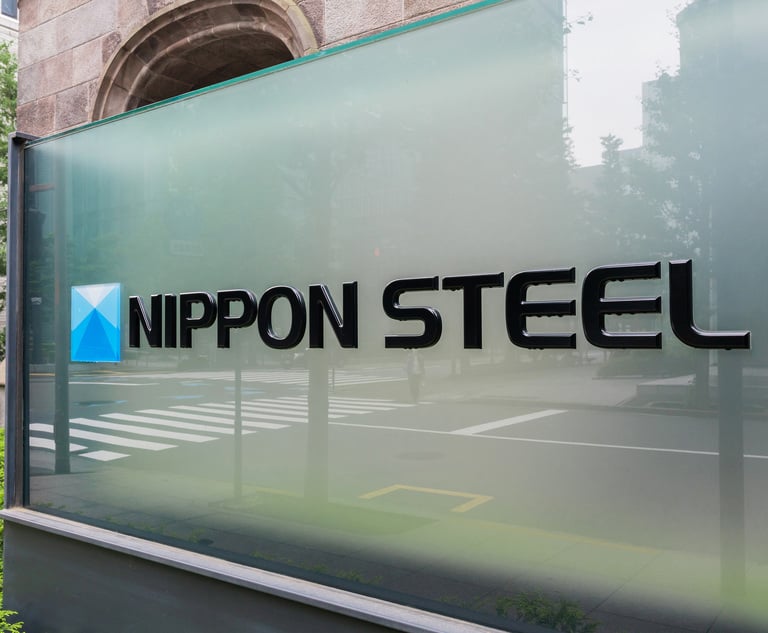Trade Lawyers Scurry for Solutions as COVID-19 Disrupts Supply Chains in Latin America
Shutdowns in Mexico have proven particularly problematic for companies that produce products seen as "essential" for the U.S.
May 01, 2020 at 12:38 PM
6 minute read
Lawyers at Hogan Lovells recently found themselves trying to unravel a stubborn supply chain kink in Mexico, where quarantine measures to prevent the spread of the new coronavirus meant several international clients were unable to produce items for an industry deemed essential in the U.S.
"Because a certain component is built in Mexico, and nowhere else, for these companies in the U.S., they don't have anywhere else to go," said Jorge Yañez, a partner at Hogan Lovells in Mexico. "They don't have a plan B right now for those components. They just have their supplier in Mexico, and that's it."
Trade lawyers are scurrying for solutions as stringent quarantines south of the border further disrupt global supply chains that have already been in disarray for months. They say it's been a wild ride helping clients in Latin America source materials during the pandemic, while navigating ever-shifting rules and multiple free trade zones.
Chandri Navarro, a partner at Hogan Lovells in Washington, D.C., who advises on customs and trade law, says she's been working seven days a week, at all hours of the day and night, to assist clients around the globe since January.
"It's been nuts," said Navarro, who describes many of her conversations with clients as efforts to walk them through issues that resemble a "snowball."
Discussions behind the scenes are underway to open manufacturing for a host of products in Mexico, from cars to electronics, as the U.S. inches closer to restarting the economy. But Mexico —a key supplier of both parts and finished goods for the U.S.— is farther behind on the infection curve and officials there are wary of putting their people at risk.
Nearly a dozen U.S. senators penned a letter to Secretary of State Michael Pompeo on Wednesday urging him to "engage with the Mexican government to protect the stability of U.S. supply chains during the COVID-19 pandemic."
In particular, the senators want the Mexican government to give the green light for workers there to make components for the food, medical, transportation, infrastructure, aerospace, automotive and defense sectors.
Mexico's export-driven $1.2 billion economy depends heavily on U.S. customers. However, outbreaks and deaths have already been reported at assembly plants along the U.S.-Mexico border, where Mexicans have protested against working during the pandemic.
Mexican Foreign Minister Marcelo Ebrard said Thursday that the country plans to stick to its own calendar for reopening. That implies a shutdown that began March 31 will extend through at least May 17.
"The priority of Mexico today is the health and protection of the sick and the Health Ministry measures to avoid contagion," Ebrard said when asked to respond to the appeal from the U.S. senators.
Mexican authorities lack the manpower to enforce compliance with quarantine measures. Hogan Lovells' Yañez says a client in central Mexico received a visit from an official with the National Migration Institute, who promised to send a Labor Ministry official for followup.
Some companies fall in a gray area as to whether they may stay in business. Others choose to keep production going, at the risk of sanctions.
"For clients who don't have any way to justify a decision to stay open, we advise them to close," said Yañez. "The problem with a sanction is they won't be able to reopen when quarantine ends."
|Supply Chains in Disarray
Supply chain disruptions began for Latin America in January, when commercial flights from China that typically carry heaps of cargo were canceled to prevent the spread of COVID-19.
The next major challenge became sourcing masks and personal protection equipment as the U.S. and dozens of other countries issued bans on exports of those critical goods. Traditionally, personal protection equipment has not been manufactured in Latin America.
U.S. companies wondered whether they could ship masks to production lines at their affiliates in the region, while apparel makers in Central America sought to switch production to personal protection gear.
Hogan Lovells' Navarro says she was contacted a few days ago by a factory that was hoping to export personal protection equipment from a free trade zone in Guatemala.
Guatemala has strict quarantine measures in place, including a national curfew and work stoppages for industries that aren't essential to the country's security, food production, sanitation or infrastructure. Airport operations and routine commercial flights out of Guatemala have been suspended.
But companies in free zones often operate by their own set of rules. And rules on who can operate where, and export what, change daily.
"It's really like the Wild West, everybody is jumping in" to produce protective gear, said Navarro.
Some countries reduced duties on personal protective gear, even though import duties are a rich source of revenue for many smaller economies in Latin America.
Navarro advises clients to be proactive with their local authorities to make sure they're in compliance with fast-changing regulations.
Businesses that must be partially or entirely closed during the pandemic, she says, could be sitting on millions of dollars worth of raw materials that were imported duty-free and will face taxes unless assembled for export.
If governments are offering the equivalent of a "snow day," says Navarro, businesses must get that commitment in writing.
Ashley Craig, co-chair of Venable's international trade group in D.C., advises clients to reach out regularly to business groups and other stakeholders in addition to government contacts to keep tabs on developments.
"Don't simply sit by and be consumed by events—keep working on mitigating the impact of the changing economy, with an eye towards a return to normalcy," said Craig. "Collaboration is key in these times."
Trade in Latin America appears to be on the decline, says Craig, in line with slowed economic activity around the globe. Yet he continues to see intense interest in sourcing personal protection equipment after having previously helped end-users identify suppliers to ship those scarce materials to various points in the region.
This content has been archived. It is available through our partners, LexisNexis® and Bloomberg Law.
To view this content, please continue to their sites.
Not a Lexis Subscriber?
Subscribe Now
Not a Bloomberg Law Subscriber?
Subscribe Now
NOT FOR REPRINT
© 2025 ALM Global, LLC, All Rights Reserved. Request academic re-use from www.copyright.com. All other uses, submit a request to [email protected]. For more information visit Asset & Logo Licensing.
You Might Like
View All
Milbank, Wachtell, Ropes and Pittsburgh Duo Aim to Save Nippon Steel's US Steel Merger


Kirkland, Macfarlanes Act as Evelyn Partners Offloads £700M Professional Services Arm
2 minute readLaw Firms Mentioned
Trending Stories
Who Got The Work
Michael G. Bongiorno, Andrew Scott Dulberg and Elizabeth E. Driscoll from Wilmer Cutler Pickering Hale and Dorr have stepped in to represent Symbotic Inc., an A.I.-enabled technology platform that focuses on increasing supply chain efficiency, and other defendants in a pending shareholder derivative lawsuit. The case, filed Oct. 2 in Massachusetts District Court by the Brown Law Firm on behalf of Stephen Austen, accuses certain officers and directors of misleading investors in regard to Symbotic's potential for margin growth by failing to disclose that the company was not equipped to timely deploy its systems or manage expenses through project delays. The case, assigned to U.S. District Judge Nathaniel M. Gorton, is 1:24-cv-12522, Austen v. Cohen et al.
Who Got The Work
Edmund Polubinski and Marie Killmond of Davis Polk & Wardwell have entered appearances for data platform software development company MongoDB and other defendants in a pending shareholder derivative lawsuit. The action, filed Oct. 7 in New York Southern District Court by the Brown Law Firm, accuses the company's directors and/or officers of falsely expressing confidence in the company’s restructuring of its sales incentive plan and downplaying the severity of decreases in its upfront commitments. The case is 1:24-cv-07594, Roy v. Ittycheria et al.
Who Got The Work
Amy O. Bruchs and Kurt F. Ellison of Michael Best & Friedrich have entered appearances for Epic Systems Corp. in a pending employment discrimination lawsuit. The suit was filed Sept. 7 in Wisconsin Western District Court by Levine Eisberner LLC and Siri & Glimstad on behalf of a project manager who claims that he was wrongfully terminated after applying for a religious exemption to the defendant's COVID-19 vaccine mandate. The case, assigned to U.S. Magistrate Judge Anita Marie Boor, is 3:24-cv-00630, Secker, Nathan v. Epic Systems Corporation.
Who Got The Work
David X. Sullivan, Thomas J. Finn and Gregory A. Hall from McCarter & English have entered appearances for Sunrun Installation Services in a pending civil rights lawsuit. The complaint was filed Sept. 4 in Connecticut District Court by attorney Robert M. Berke on behalf of former employee George Edward Steins, who was arrested and charged with employing an unregistered home improvement salesperson. The complaint alleges that had Sunrun informed the Connecticut Department of Consumer Protection that the plaintiff's employment had ended in 2017 and that he no longer held Sunrun's home improvement contractor license, he would not have been hit with charges, which were dismissed in May 2024. The case, assigned to U.S. District Judge Jeffrey A. Meyer, is 3:24-cv-01423, Steins v. Sunrun, Inc. et al.
Who Got The Work
Greenberg Traurig shareholder Joshua L. Raskin has entered an appearance for boohoo.com UK Ltd. in a pending patent infringement lawsuit. The suit, filed Sept. 3 in Texas Eastern District Court by Rozier Hardt McDonough on behalf of Alto Dynamics, asserts five patents related to an online shopping platform. The case, assigned to U.S. District Judge Rodney Gilstrap, is 2:24-cv-00719, Alto Dynamics, LLC v. boohoo.com UK Limited.
Featured Firms
Law Offices of Gary Martin Hays & Associates, P.C.
(470) 294-1674
Law Offices of Mark E. Salomone
(857) 444-6468
Smith & Hassler
(713) 739-1250








